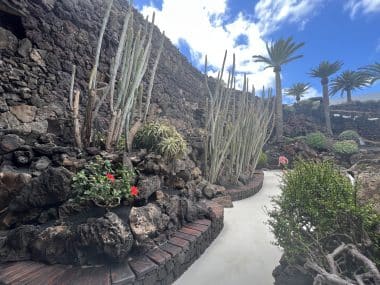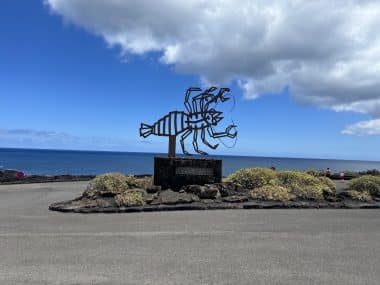The Jameos del Agua are lava caves in the north of the Canary Island of Lanzarote, which are now an art and exhibition center in a fascinating environment. The nearest municipality is Haría. The naturally formed caves began to be transformed into a cultural center by local architect and artist César Manrique in the 1960s. Today, the government of Lanzarote manages the facility, which includes an underground salt lake, gardens, a restaurant, a museum and an auditorium.
Natural formation of the Jameos del Agua
The literal translation of “Jameos del Agua” would mean something like “tubes in the water”. Agua is the Spanish word for water, while the word Jameo in the local dialect refers to large openings in lava tubes that are formed during natural collapses in the volcanic structure. The surrounding volcanic tube was formed at least 3,000 years ago during the last eruption of Monte Corona (also La Corona = “the crown”), the central volcano of Lanzarote. This tube has a total length of 6 km, at least 1.5 km of which are below the surface of the sea. A local nickname is “Tunnel of Atlantis” because a (again local) legend claims that the path to the legendary sunken city of Atlantis leads through this tube. The Jameos del Agua were formed by geological activity in the coastal section of the volcanic tube. They consist of the three main parts
- Jameo Grande,
- Jameo la Cazuela and
- Jameo Chico.
Access to the interior is possible via the Jameo Chico.
Architectural intervention by César Manrique

César Manrique carefully redesigned the volcanic space to make it safe for visitors. They are supposed to see from the natural attraction that there was (almost) no human intervention. Manrique created several such centres for the design of art in the natural environment, which quickly became tourist attractions and therefore also received funding from the respective local governments. The Jameos del Agua were his first work half a century ago, he came from Lanzarote. His idea was to bring his artistic work into harmonious harmony with nature. The Jameos del Agua were first opened to visitors in 1966, but at that time they did not yet have the official status of a visitor center. After that, there were changes to the original project, which were due to the special morphology of the volcanic tube. They made visiting the caves even safer, and at the same time Manrique was able to try out creative alternatives. Finally, in 1977, the local government officially opened the center. Later, other components were added, such as the museum “Casa de los Volcanes”.
What can visitors to Jameos del Agua expect?
Inside the Jameos del Agua, visitors enter a natural basalt auditorium that can accommodate 550 people and has exceptional acoustics. Among other things, concerts are offered here. The seats follow the natural ground inclination in their position. The cave houses an underground lague with crystal clear water and a depth of 7 m. The water is seawater that filtered into the cave, which in turn is below sea level. A unique volcanic ecosystem with 77 endemic species was created here, which therefore only exist here and nowhere else in the world. The most famous is the blind crab Munidopsis Polymorpha, which became the symbol of the Jameos del Agua. It is considered extremely endangered and, among other things, does not tolerate any metal, not even traces of it. Visitors to the cave are therefore advised that they are not allowed to throw coins into the lagoon under any circumstances, which is a popular custom elsewhere.
Similar rooms in Lanzarote

In the 1960s, Lanzarote began to open up to tourism. César Manrique, together with other artists and initiators (José Ramirez as chairman, Luis Morales, Jesús Soto, Antonio Álvarez and Ildefonso Aguilar), founded the Cabildo de Lanzarote, which promoted art projects of this type specifically for tourist activities in order to revitalize the local economy. For this purpose, the actors selected areas of Lanzarote that are characterized by special scenic attractions. The projects in question, which still exist today, are (each with the year of the start of construction):
- Cueva de los Verdes (1964)
- Jameos del Agua (1966)
- 1968: Casa-Museo del Campesino
- 1970: Restaurant El Diablo
- Mirador del Río (1973)
- 1976: MIAC-Castillo de San José
- 1991: Kakteengarten
These seven rooms are all worth a visit. They prove the synthesis that art can enter into with nature.


